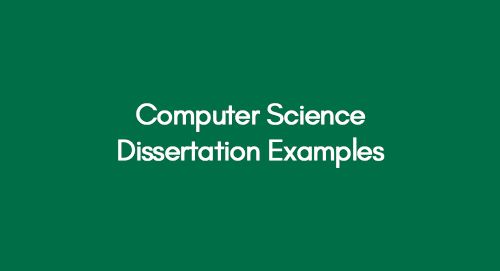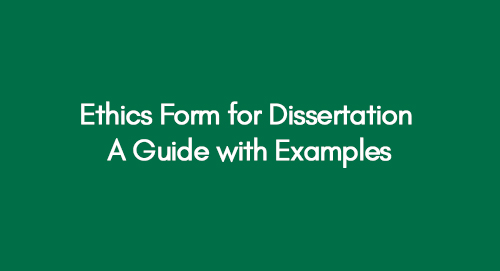
Latest Early Childhood Studies Dissertation Examples
February 14, 2023
Latest Computer Science Dissertation Examples For Students
February 15, 2023Writing a dissertation can be overwhelming when you don’t know where to get started.
A dissertation is a comprehensive research paper that showcases your knowledge and skills in a specific field of study. An abstract is its first and most important part, which acts as a roadmap for your entire research paper.
Find Quality Dissertation Topics by Premier Dissertations
In this blog post, we will guide you through the process of writing a compelling abstract example dissertation. Whether you are a seasoned academic or a first-time dissertation writer, our tips and tricks will help you create an abstract that accurately represents your research and captures the attention of potential readers.
Consider the following links with the dissertation abstract example for a head start;
Example: 1 Insight into Alternative Dispute Resolution and Its Execution
Example: 2 Influence of Socio-Physical Attributes on Individual's Weight
What is an Abstract?
An abstract is a brief description of a lengthy work or research paper. The abstract helps your readers understand the study by succinctly summarizing the objectives and findings of your research.
Your abstract should outline the research goal, employed techniques, and the conclusions of the study. The format may vary significantly based on your discipline and university norms. Hence, it is advised to consult your university library for appropriate formatting.
The average length of an abstract is between 100 and 250 words, one or two paragraphs. You may be required to extend it to include everything because abstracts for complicated dissertations must also be more elaborate. Abstracts frequently take up the full page, especially in advanced science books.
Click on the link below to find more thesis abstract examples from professional A grade masters thesis.
Importance of Abstract
The abstract is one of the most critical parts of a dissertation, as it provides the first impression of your work. A well-written abstract can illuminate your readers and encourage them to read the rest of your paper. It can also be used as a standalone piece. Therefore, it is essential to take the time to craft a clear and compelling abstract that accurately reflects the content of your dissertation.
A dissertation’s abstract serves two purposes.
- Selection: Abstracts enable potential readers to rapidly assess if the article is relevant to their desired outcomes and whether they need to read the entire document.
- Indexing: You can search abstracts in the majority of academic journal databases that you can access through the library. Users could quickly get data thanks to this. The essential terms that a potential researcher might use to seek must be included in the abstract.
Also, dissertation abstracts are important because they are a requirement for:
- Paper submission to journals
- Thesis Submission
- Research Fund Applications
- Submission of conference paper and proposals
Review the dissertation abstract sample from the following dissertation.
Dissertation Example: Corporate Veil Lifting Approaches in UK and USA
IMRaD Approach for Dissertation Abstract Structure
The IMRaD structure is a way of organizing your thoughts and ideas when writing a dissertation abstract. It stands for Introduction, Methods, Results, and Discussion. This structure will help ensure that your abstract is clear, concise, and easy to read. Keep in mind that each section’s explanation shouldn’t exceed more than 2 to 3 lines.
1. Introduction
The introduction should provide an overview of your topic and explain why it is important. It should also briefly describe the methods you used to research your topic.
- What is the significance of the research?
- What makes the whole work appealing to a reader?
- What problem is this research trying to address?
- What is the project's scope? What is the major thesis, assertion, or argument?
2. Methods
In the methods section, you will need to describe the research methods you used to collect data and information for your dissertation. It should be clear and concise so that readers can understand what you did and how you did it.
3. Results
The results part is where you will present the findings of your research. This section should be easy to read and understand, as it will likely be the most important part of your dissertation for many readers. Be sure to include any figures that will help to illustrate your results.
4. Discussion
In the discussion section, you will interpret the results of your research and discuss their implications. This section should also address any limitations of your study and suggest areas for future research.
- How does this research further our understanding of the specific topic?
- Are there any theoretical or practical consequences from your research or any ramifications for upcoming research?
Steps for Writing an Abstract Example Dissertation
1. Analyze the Article or Paper's Purpose & Content
Before beginning the writing process, it's important to understand your goal when writing an abstract. Start by reading through your entire article or paper and analyzing its purpose. Ask yourself questions like:
- What are the key points of this document?
- What does the reader need to know about this?
It will provide you with a better understanding of what should be included in your abstract and accurately reflect all key aspects of your work.
2. Compose Your Abstract
Now that you clearly understand what needs to appear in your abstract, it's time to start writing! Ensure each sentence within your abstract directly relates to one of the primary goals or objectives outlined in your original article or paper.
Additionally, try to keep your sentences concise yet informative - don’t use too many words but also make sure you give enough information for readers to get a good idea of what you wrote about.
Here's a dissertation abstract example; go through this to check how to write one properly.
This assignment aims to evaluate the influence caused by different physical attributes (age, gender, and height) and social attributes (income and smoking status) on an individual's weight. Therefore, the following description is associated with the Statistical analysis of healthcare data.
To effectively achieve the aim, quantitative data for each variable has been taken into consideration from 1350 respondents having different physical and social attributes. It has been assumed that the data is normally distributed, and there is no problem with multicollinearity and linear relationship of variables. Multiple regression has been used as the major data analysis technique. The results have indicated that the model is relevant in statistical terms as the overall sig value appears to be less than the benchmark value of alpha. However, while judging the attributes individually, it was found that age does not tend to impact an individual's weight.
3. Include Relevant Keywords & Phrases
Include relevant keywords and phrases throughout your abstract so that search engines can easily recognize it as related content when someone searches for topics related to yours.
Try including words that may appear in typical search queries, such as "research methods," "data analysis," etc., depending on the subject matter of your work.
You may also want to consider using synonyms to describe concepts more effectively and avoid repeating words too often throughout the piece; however, make sure not to overuse them either, as this can become confusing for readers unfamiliar with more obscure terms used in place of common ones!
Connect With Writer Now
Discuss your requirements with our writers for research assignments, essays, and dissertations.
Dissertation Abstract Example
Here are some abstract dissertation examples. To get access to the whole dissertation example, you can check out the links provided below:
- An Insight into Alternative Dispute Resolution (ADR) and How this is Executed to Solve Common Construction Disputes.
- The Abuse of Corporate Veil: A Comparative Analysis of Corporate Veil Lifting Approaches in UK and US laws
The following dissertation abstract example is a reference for aspiring dissertation authors.
The construction industry suffers from frequent conflicts and disputes between all parties involved in construction contracts. This is because the industry is ever-evolving, making it more complex and leading to further complications. In this thesis, construction professionals conducted semi-structured interviews and questionnaires within the context of alternative dispute resolution (ADR). The main goal of the study was to determine the relationship between cost and time within the ADR sector and signify the effects of this in comparison to traditional methods, also to determine the type and frequency of conflicts and factors that influence the transition into disputes.
This thesis explores an extensive literature review which summarizes the main definitions of disputes and conflicts. The thesis also explores a brief background of Alternative dispute resolution (ADR) and how this originated to become part of the standard form of contract and the main method of dispute resolution. Furthermore, the literature explores the ways within ADR and the circumstances in which the process is used. Once analyzed, the three research methods were triangulated to form conclusions and make recommendations. The main findings indicate that conflicts and disputes are an inevitable factor in the construction industry due to the complex nature of the industry and the vast amount of interdependent parties involved. They can occur at any time in the process, even before design work is carried out. Furthermore, the findings show that ADR, compared to litigation, is much more effective and efficient in terms of time and cost. However, there is still a place for legal proceedings that should take the dispute spiral out of control in terms of costs.
The findings also presented the most common causes of dispute. In some way or other, the results from both the literature and primary data have identified the same recurring causes for many years, indicating a potential link between these disputes requiring further scope for study. Solutions found, including early interventions of conflict, can significantly impact saving cost, time, relations and how disputes develop.
Here’s another dissertation abstract example to check out:
The current research analyses the doctrine of veil piercing using a comparative method of legal analysis between the United States and the United Kingdom. The purpose of the current study was to examine the usage of the veil-piercing doctrine to implement its principles in fraudulent bankruptcy proceedings. The study assesses the long history associated with separate corporate identity, its benefits, and drawbacks in the context of the markets of the United States and the United Kingdom. The separate corporate form introduced under limited liability companies was to reinvigorate businesses by providing them with a safety net.
However, the research indicates that various instances have taken place that allows individuals to act illegitimately under the guise of a legally separate corporate form. The research also analyses various bankruptcy measures in the United States and the United Kingdom in terms of their foundations, legal proceedings, and case conclusions. The current research rationalizes that there is a pretext for using the veil-piercing doctrine to lift the veil for companies that may be using insolvency and bankruptcy to commit fraud. It is recommended that both the US and the UK set precedents in corporate law by enacting legislation that includes these premises of veil piercing to deter individuals from fraud and protect the separate corporate identity.
Guaranteed Plagiarism-Free Work
Get 100% human generated plagiarism-free research content from our expert writers!
Tips For Writing a Compelling Abstract
- Be Concise: The abstract should be brief yet complete. Be careful to exclude any extraneous details and just provide the most relevant elements.
- State the Purpose: Clearly state the purpose of your research, including the problem you are trying to solve or the question you are trying to answer.
- Outline the Methods: Briefly describe the methods you used to conduct your research, including the study design and data collection techniques.
- Summarize the Results: Summarize the main findings of your research, including any significant results and their implications.
- Highlight the Conclusions: Discuss the conclusions you have drawn from your research, including any new insights or recommendations.
- Use Strong Language: Choose strong and descriptive words to convey the importance of your research. Avoid vague or passive language.
- Proofread: Make sure to proofread your abstract carefully for grammatical errors, typos, and other mistakes.
Conclusion
Writing a compelling abstract for your dissertation is an important task that requires careful consideration and attention to detail. By following the structure and tips outlined in this guide, you can craft an abstract that accurately represents your research and captures the attention of potential readers. If you need a dissertation abstract template, then feel free to contact Premier Dissertations.
Get an Immediate Response
Discuss your custom requirements with our writers
Free Online Plagiarism Checker For Students
We will email you the report within 24 hours.
Upload your file for free plagiarism





























